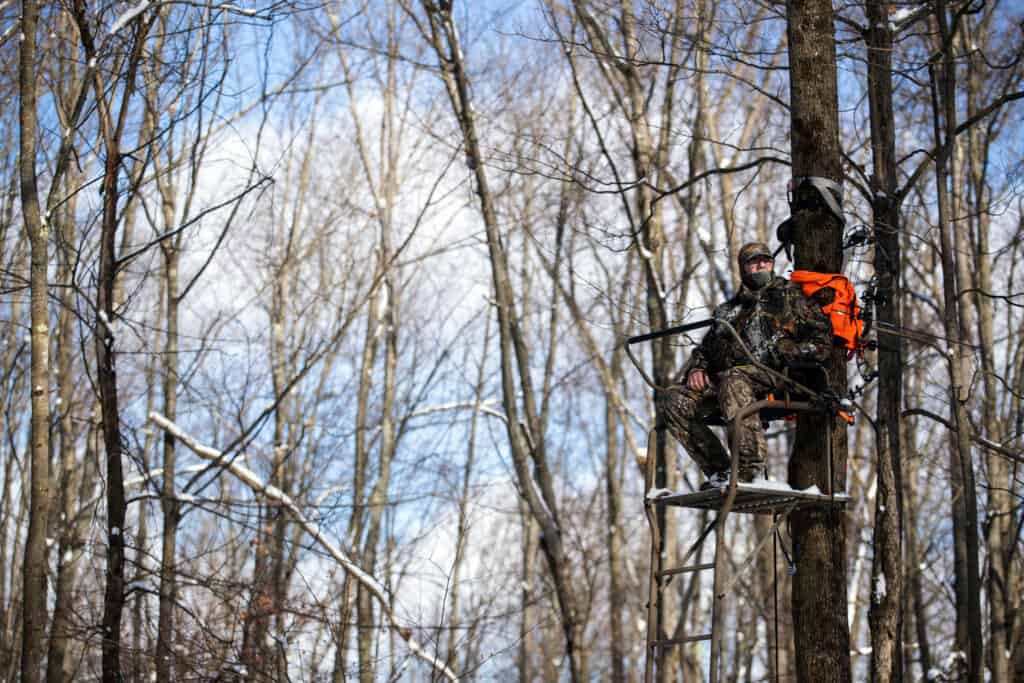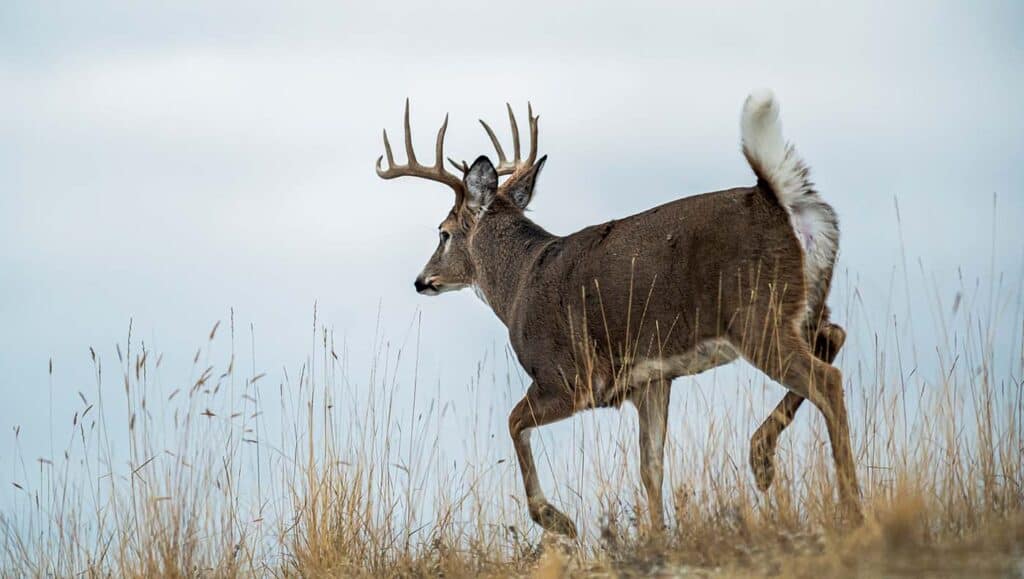Hunters, and people in general, will find a way to disagree about almost anything. How often you should hunt from the same deer stand is no exception to that rule. Ask your three hunting buddies and you’re likely to get four different answers, with little room for compromise or nuance.
A consensus among hunters is pretty hard to come by. Every piece of the equipment you use is either “right” or “wrong” depending on who you ask, and theories on stand burnout are no different. Scroll through the first page of an online search and you’ll walk away with no clearer idea of what’s correct or not than when you started. I’ll try to simplify the answer here though.
You can hunt the same stand on back-to-back hunts, but the more often you visit a stand, the more you alert deer to your presence. If you hunt a stand twice or know you have spooked deer during your hunt, it’s a good idea to give that stand a few days to cool down before going back in.
Simple, right?.. Not so much. There are many factors at play when deciding how often to hunt a stand. One blanket answer can’t possibly be right for each of the millions of hunters in our country. Keep reading and I’ll help you get a better idea of how to manage your own individual stand schedule.

A Case for Hunting a Stand Repeatedly
When you’re trying to decide how often to hunt a particular stand, it’s important to focus your scheduling on how deer act, not on how you would act if you were a deer. It’s a trap many hunters unknowingly fall into when picking a stand location. We end up placing a stand in a spot that looks like it should have deer instead of reading the sign and finding a place that does have deer.
The same can go for how often you hunt that perfect stand location. Let’s say you’ve patterned a buck with a trail camera and you know he’s hitting a particular trail early every morning for the last week. You’ve decided it’s time to strike, but the next morning you strike out. Did you just burn your spot for a week on a morning when he didn’t even walk by? Probably not.
Some might advise you to wait a few days, a week, or even later in the season before sitting in that spot again. For me, if I didn’t get busted in the tree and I know my entry and exit game is tight, I’d go back in there the next morning. Maybe a shift in the weather altered his schedule a little, or a coyote spooked him on his way to you, or maybe he just decided to take a different route to work that morning.
The point is, you can pattern deer and monitor their movements with trail cameras all you want, but they are living, breathing, autonomous creatures that are affected by more factors than we humans can account for. It’s probably worth going back into that same stand the next day to see if he returns to his recent pattern.
Did You Know I Had a Newsletter?! 📬
I do! I send out a weekly email that talks all about deer hunting and is a bit more personal than a regular article. If you sign up right now, I will even send you the first chapter of my Ebook “The Hunters Guide to Scent Control” for free! What is there to lose? 🙂
Shifting Patterns
Depending on where you live, deer season can last a couple of weeks or over 100 days, so hunters in different areas need to manage their stands differently. I’ve always been lucky to live in areas with long seasons. While it does make each hunt feel less urgent, it also means there are a lot of opportunities for deer to shift their patterns within the season.
These shifting patterns can take a stand that was a hotbed for acorn feeding and turn it into a ghost town once the acorns are all eaten. They can also take a lightly used trail near a bedding area and turn it into a highway during the rut as bucks check for hot does. Flexibility in your stand schedule and a willingness to hunt the hot area is crucial in these cases.
Shifting patterns like acorn drops and the rut definitely change how the whole population moves. If you want to know some of the general best spots to hang a stand during different phases of the rut, check out this article where I go over it in detail!
Staying in The Action
If there’s a good buck or a lot of deer activity localized to one area, I’m probably going to focus my efforts on the one or two stands that I have set up there. I’ve heard it said that you need to try to find the “spot within the spot” when it comes to stand location. If you’ve managed to do that and you’re seeing a lot of deer traffic, I say get in there and make the most of it.
How you hunt is also going to give you more or less flexibility with hunting the same location. For instance, a rifle hunter is able to sit much further away from their target, which limits their risk of spooking or getting winded by a cautious animal. This definitely gives a rifle hunter much more flexibility when it comes to re-hunting an area several times in a row.
Bowhunters, on the other hand, sit much closer and could have a deer within literal spitting distance. Success for bowhunters means having great awareness of where the wind is taking your scent, not just in the stand, but also on your way in and out. If the conditions are right, I don’t let it deter me from hunting multiple times from one spot, but I am more cautious and more aware of the impact I have as a bowhunter.
In the end, if you’re going to hunt back-to-back in the same location, you need to have your entry and exit strategies, as well as your scent control, on point. This helps to make sure you don’t get busted and alert deer to your presence.
Another thing that helps with scent control and staying undetected is getting high up in your tree. Although if you aren’t sure just how high you should hang your deer stand, check out this article where I did an entire study on the topic.
A Case for Letting a Stand Rest
Just like there are times to go in and re-hunt the same stand, there are going to be situations where letting a stand rest is the right answer. Deer are sensitive to change, and any time you take a walk in their woods you introduce something new into their lives. Minimizing how often you visit the same area can help reduce the impact you have on those resident deer.

Location Rotation
If you have multiple stand set ups and have the ability to rotate when you sit at each location, you’re going to run a much lower risk of educating deer to your presence. Even if you don’t bump a deer or get busted, you still leave your scent behind for deer and other animals to pick up on later. The less time you spend in one patch of woods, the less of that evidence you’ll leave.
You may end up with a natural stand rotation of sorts just based on weather conditions. Where I live, it would be rare to have wind direction remain consistent for several days in a row. If you focus on the wind, then you will probably end up having to hunt different locations just to make sure you’re playing the wind properly each time you go.
If you are a more run and gun type of hunter, you might move your entire stand around to new areas that you’ve scouted but have not hung a stand in yet. In that case, you’ll want a lightweight stand to take in and out of the woods with you. Check out my other article titled 3 Lightweight Climber Tree Stands for Mobile Deer Hunting if that sounds like your kind of hunting.
Time Limitations
Along those same lines, if you work for a living, chances are your opportunities to hunt are confined to weekends, so your stands will get a good break during the week. This makes the problem of resting stands between sits much more manageable if you only have to worry about scheduling two days of hunts.
I mentioned above that different season lengths can be a determining factor in how willing you are to hunt stands repeatedly. Not having lived it myself, I can only speculate that a short deer season would make me more concerned with burning out a particular stand location. If I only have two-to-three weeks to fill my tags, I’m going to be pretty careful about where and when I hunt.
The decision to let a stand rest can be a stressful one. The opportunity cost of leaving that stand to go somewhere else can be tough to outweigh, but having a plan in place before it’s time to make that decision can help ease some of the pain. If you believe in resting a stand, make sure you know what your strategy is beforehand and stick to it.
Be Your Own Expert
I’m a big proponent of following your gut when it comes to hunting. Despite the best efforts of today’s society to tamp it down, that primal instinct to hunt and to respond to nature still exists in our DNA. Your desire to hunt from the same location again or the feeling like you need to switch it up isn’t just random. That’s your experience and instinct telling you how to handle this situation.
No one else is going to know your hunting property or your deer population as well as you do, so why would they know the right way to hunt those deer better than you? If you feel like your deer are particularly spooky and heavily pressured, then maybe the right strategy is to make sure you don’t over-use a stand. If they’re calm and their body language is relaxed, you can probably go into that same area the next time you hunt if you want to.
The more prepared you are going into the season, the easier it will be to make crucial decisions in the middle of it. Knowing where deer bed, where they travel, where they eat, and where they water will help you set multiple stand sites. Those stand locations will give you the options you need when it’s time to decide where to hunt and how often you hunt those spots.
The Last Sit
If you’ve ever sat in a stand as the sun dipped below the horizon without seeing any deer that hunt, you’ve probably wondered what you did wrong to turn the odds against you. There’s a lot of things you could have screwed up, or none at all, but unless you’ve hunted the same spot for a week straight, sitting there back-to-back days probably doesn’t top the list.
Don’t be afraid to hunt that honey hole more than once, but also know when the time is right to change strategies. Listen to your gut, remember your preparation, and, most of all, enjoy being out there with an opportunity to harvest one of Mother Nature’s critters. Getting out of your own head and into the woods is the first step toward being successful.

